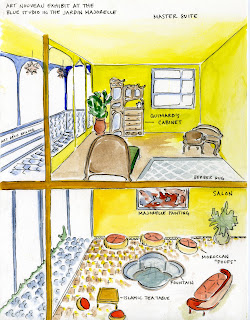

In the bustling Moroccan city of Marrakech, there's an oasis of calm and exotic foliage known as the Jardin Majorelle. Originally the residence of the French painter Jaques Majorelle; this unique property embodies the spirit of an Islamic palace and the bold theatrics of Art Deco. Reflecting pools, courtyard fountains and an extensive collection of tropical plants from around the world frame Majorelle's house and the infamous Blue Studio, where the artist once painted.
Jaques Majorelle was the son of well-known Art Nouveau furniture maker Louis Majorelle, who was a key member in the influential French Nancy School. In the early 1900's, the Nancy School brought artists, architects and industrialists together who sought to promote Art Nouveau and ensure a high standard of quality in the decorative arts.
Louis' dedication to the arts was soon shared by his son Jaques, who studied at the Ecole des Beaux-Arts and later on, at the Academie Julien. Jaques established himself as a painter and took much of his artistic inspiration from his travels to the south, beginning in Spain and eventually leading to Northern Africa and beyond. In 1919, Jaques moved to Morocco and eventually took up residence in Marrakech at the Jardin Majorelle.
Nearly a decade after his move to the Jardin Majorelle, Jaques commissioned architect Paul Sinoir to design a vast workshop that would become known as the infamous Blue Studio where Jaques spent his days working in watercolor. Drawing from French Colonial architecture and Islamic vernacular architecture, Sinoir created an Art Deco villa inspired by Le Corbusier and the Bahia Palace of Marrakech. As the name implies, the facade of the Blue Studio is a shade of electric blue now internationally recognized as "Majorelle Blue". Long balconies skirted by horizontal tubular steel railings are shaded by cantilevered planes jutting out toward the landscape. Meanwhile, gorgeous carved plaster work, spindly columns and ornate arches blend an Islamic aesthetic into the Art Deco architecture, which makes for a playful crossing of cultures.
As one looks to the second floor of the Blue Studio where the current Art Nouveau exhibit floods into the master suite, the work of Louis Majorelle is displayed alongside pieces by his peers from the Art Nouveau movement. Hector Guimard's cabinet is one piece in particular that resonates with Sinoir's architecture as if it grew from the foundation. Vertical tendrils mimic spindly columns, as outstretched cabinetry parallels cantilevered roofing. Large planes of mirrored glass reflect banded windows and carved wood nods to carved plaster in an overwhelming appreciation for plant life. Perhaps this comparison is only natural as one examines Art Nouveau and it's inclination to pull from the Orient to create an innovative, industrial and organic designs, which ultimately stem from a European perspective. This summation could be applied to Paul Sinoir and his Blue Studio, and it is a pleasure to experience Art Nouveau as an added layer to this multi-cultural applique.
Sources include: www.jardinmajorelle.com
Contrasting Building: MGM's stage 26 in Culver City, CA stands in clear contrast to the Blue Studio. Stage 26's function as a movie set requires a somewhat generic facade (in this case a brick box), which is far from the bright blue Art Deco/Islamic palace facade of the Blue Studio.
Stage 26 is a building that directs inwards toward the interior set where all of the action takes place, while the Blue Studio opens up towards the surrounding grounds through outstretched cantilevered roofing, large openings and broad balconies.
Similar Building: Greensboro North Carolina's Italian mansion known as "Blandwood" is a fine example of the crossing of cultures through design. Not unlike the Blue Studio, Blandwood sits surrounded by heritage plantings and a carefully managed flower garden. Both buildings open up to their respective landscapes through large openings and outstretched gestures in stucco.
Blandwood's many arched arcades flanking either side of it's towered entrance, are similar to the arches that support balconies throughout the Blue Studio, which give credit to the Italian and Islamic design influences taking place.


No comments:
Post a Comment